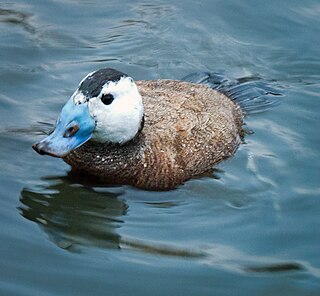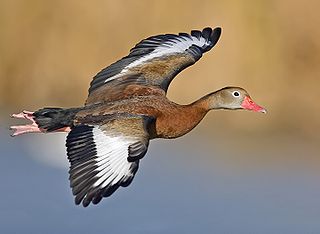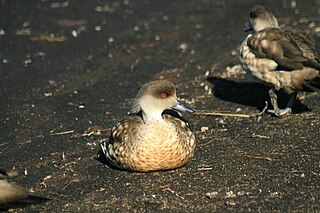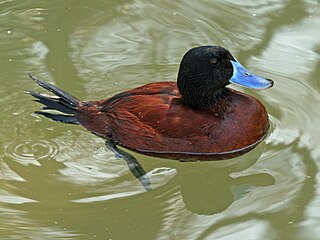
The canvasback is a species of diving duck, the largest found in North America.

The American black duck is a large dabbling duck in the family Anatidae. It was described by William Brewster in 1902. It is the heaviest species in the genus Anas, weighing 720–1,640 g (1.59–3.62 lb) on average and measuring 54–59 cm (21–23 in) in length with an 88–95 cm (35–37 in) wingspan. It somewhat resembles the female and eclipse male mallard in coloration, but has a darker plumage. The male and female are generally similar in appearance, but the male's bill is yellow while the female's is dull green with dark marks on the upper mandible. It is native to eastern North America. During the breeding season, it is usually found in coastal and freshwater wetlands from Saskatchewan to the Atlantic in Canada and the Great Lakes and the Adirondacks in the United States. It is a partially migratory species, mostly wintering in the east-central United States, especially in coastal areas.

The tufted duck or tufted pochard is a small diving duck with a population of close to one million birds, found in northern Eurasia. The scientific name is derived from Ancient Greek aithuia, an unidentified seabird mentioned by authors including Hesychius and Aristotle, and Latinfuligo "soot" and gula "throat".

The musk duck is a highly aquatic, stiff-tailed duck native to southern Australia. It is the only living member of the genus Biziura. An extinct relative, the New Zealand musk duck or de Lautour's duck, once occurred on New Zealand, but is only known from prehistoric subfossil bones. It was about 8% longer than the living species, with a particularly large head.

The ruddy duck is a duck from North America and one of the stiff-tailed ducks. The genus name is derived from Ancient Greek oxus, "sharp", and oura, "tail", and jamaicensis is "from Jamaica".

The ferruginous duck, also known as ferruginous pochard, common white-eye or white-eyed pochard, is a medium-sized diving duck from Eurosiberia. The scientific name is derived from Greek aithuia an unidentified seabird mentioned by authors including Hesychius and Aristotle, and nyrok, the Russian name for a duck.

The red-crested pochard is a large diving duck. The scientific name is derived from Greek Netta "duck", and Latin rufina, "golden-red". Its breeding habitat is lowland marshes and lakes in southern Europe and it extends from the steppe and semi-desert areas on the Black Sea to Central Asia and Mongolia, wintering in the Indian Subcontinent and Africa. It is somewhat migratory, and northern birds winter further south into north Africa.

The ruddy shelduck, known in India as the Brahminy duck, is a member of the family Anatidae. It is a distinctive waterfowl, 58 to 70 cm in length with a wingspan of 110 to 135 cm. It has orange-brown body plumage with a paler head, while the tail and the flight feathers in the wings are black, contrasting with the white wing-coverts. It is a migratory bird, wintering in the Indian subcontinent and breeding in southeastern Europe and central Asia, though there are small resident populations in North Africa. It has a loud honking call.

The black-headed duck is a South American duck in subfamily Oxyurinae of family Anatidae. It is found in Argentina, Bolivia, Brazil, Chile, Paraguay, and Uruguay.

The white-headed duck is a small diving duck some 45 cm (18 in) long. The male has a white head with black crown, a blue bill, and reddish-grey plumage. The female has a dark bill and rather duller colouring. Its breeding habitat is lakes with open water and dense vegetation at the margin. It dives under water and feeds on aquatic vegetation as well as some animal matter. It is more likely to swim away from a perceived threat than to fly. This duck is known from Spain, North Africa, Western Asia and Central Asia. Populations are declining, mostly due to loss of habitat and pollution, and the International Union for Conservation of Nature has rated the bird's status as "endangered".

The rosy-billed pochard, alternatively named rosybill or rosybill pochard, is a member of family Anatidae. Though classified as a diving duck, this pochard feeds more like a dabbling duck feeding on seeds roots, sedges, aquatic plants and other grasses. Netta is Ancient Greek for "duck" and peposaca is a transcription of the Guaraní name of this species which means "showy wings", referring to the broad white stripe that is only visible with stretched out wings. Male characteristic features include a bright red bill with a rounded knob at the base.

The fulvous whistling duck or fulvous tree duck is a species of whistling duck that breeds across the world's tropical regions in much of Mexico and South America, the West Indies, the southern United States, sub-Saharan Africa and the Indian subcontinent. It has plumage that is mainly reddish brown, long legs and a long grey bill, and shows a distinctive white band across its black tail in flight. Like other members of its ancient lineage, it has a whistling call which is given in flight or on the ground. Its preferred habitat consists of wetlands with plentiful vegetation, including shallow lakes and paddy fields. The nest, built from plant material and unlined, is placed among dense vegetation or in a tree hole. The typical clutch is around ten whitish eggs. The breeding adults, which pair for life, take turns to incubate, and the eggs hatch in 24–29 days. The downy grey ducklings leave the nest within a day or so of hatching, but the parents continue to protect them until they fledge around nine weeks later.

The ruddy-headed goose is a species of waterfowl in tribe Tadornini of subfamily Anserinae. It is found in Argentina, Chile, and the Falkland Islands.

The black-bellied whistling duck, formerly called the black-bellied tree duck, is a whistling duck that before 2000 bred mainly in the southernmost United States, Mexico, and tropical Central to south-central South America. It can be found year-round in much of the United States. It has been recorded in every eastern state and adjacent Canadian province. Since it is one of only two whistling duck species native to North America, it is occasionally just known as the "whistling duck" or "Mexican squealer" in the southern USA.

The blue-billed teal, spotted teal or Hottentot teal is a species of dabbling duck of the genus Spatula. It is migratory resident in eastern and southern Africa, from Sudan and Ethiopia west to Niger and Nigeria and south to South Africa and Namibia. In west Africa and Madagascar it is sedentary.

The crested duck or South American crested duck is a species of duck native to South America, belonging to the monotypic genus Lophonetta. It is sometimes included in Anas, but it belongs to a South American clade that diverged early in dabbling duck evolution. There are two subspecies: L. specularioides alticola and L. specularioides specularioides. The Patagonian crested duck is also called the southern crested duck and its range lies in the Falklands, Chile, and Argentina.

The masked duck is a tiny stiff-tailed duck ranging through the tropical Americas.

The lake duck is a small, South American stiff-tailed duck. It is also called the Argentine blue-bill, Argentine blue-billed duck, Argentine lake duck, or Argentine ruddy duck.

The blue-billed duck is a small Australian stiff-tailed duck, with both the male and female growing to a length of 40 cm (16 in). The male has a slate-blue bill which changes to bright-blue during the breeding season, hence the duck's common name. The male has deep chestnut plumage during breeding season, reverting to a dark grey. The female retains black plumage with brown tips all year round. The duck is endemic to Australia's temperate regions, inhabiting natural inland wetlands and also artificial wetlands, such as sewage ponds, in large numbers. It can be difficult to observe due to its cryptic nature during its breeding season through autumn and winter. The male duck exhibits a complex mating ritual. The blue-billed duck is omnivorous, with a preference for small aquatic invertebrates. BirdLife International has classified this species as Least concern. Major threats include drainage of deep permanent wetlands, or their degradation as a result of introduced fish, peripheral cattle grazing, salinization, and lowering of ground water.

The Maccoa duck is a stiff-tailed diving duck found across Eastern and Southern Africa.






















